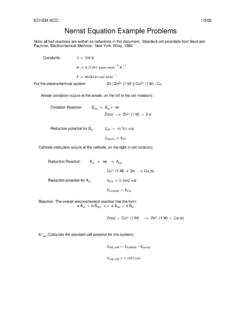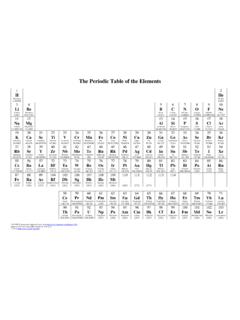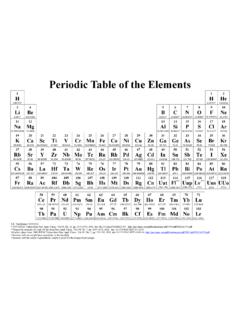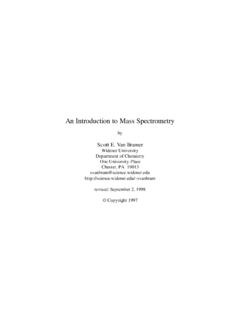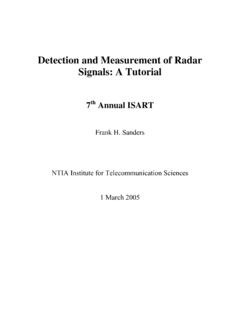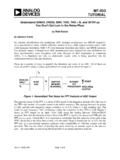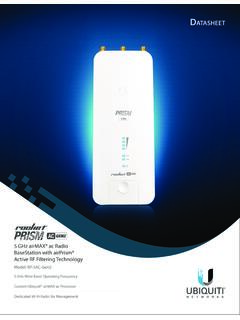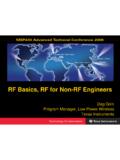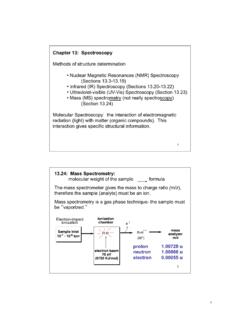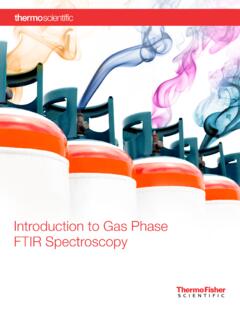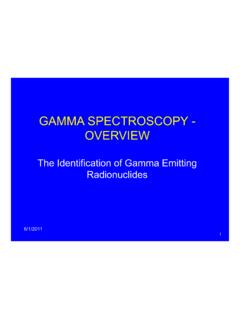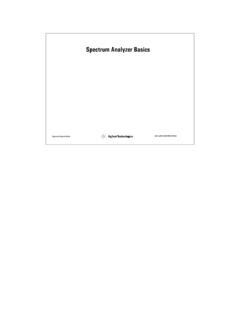Transcription of An Introduction to Mass Spectrometry - Widener University
1 An Introduction to mass Spectrometry by Scott E. Van Bramer Widener University Department of Chemistry One University Place Chester, PA 19013. ~svanbram revised: September 2, 1998. Copyright 1997. TABLE OF CONTENTS. Introduction .. 4. SAM PLE Introduction .. 5. Direct Vapor Inlet .. 5. Gas Chromatography .. 5. Liquid Chromatography .. 6. Direct Insertion Probe .. 6. Direct Ionization of Sample .. 6. IONIZATION TECHNIQUES .. 6. Electron Ionization .. 7. Chemical Ionization .. 9. Fast Atom Bombardment and Secondary Ion M ass Spectrometry .. 10. Atmospheric Pressure Ionization and Electrospray Ionization .. 11. M atrix Assisted Laser Desorption/Ionization .. 13. Other Ionization M ethods .. 13. Self-Test #1 .. 14. M ASS ANALYZERS .. 14. Quadrupole .. 15. M agnetic Sector .. 17. Electric Sector/Double Focusing M ass Spectrometers .. 18. Time-of-Flight .. 19. Quadrupole Ion Trap .. 21. Ion Cyclotron Resonance.
2 22. Self-Test #2 .. 23. DETECTORS .. 23. VACUUM SYSTEM .. 24. DATA SYSTEM .. 24. INTERPRETATION .. 24. M olecular Ion .. 25. Fragmentation .. 26. Isotope Abundance .. 31. Exact M ass .. 33. ACKNOWLEDGM ENTS .. 34. END OF PAPER QUESTIONS .. 35. ANSWERS TO SELF-TEST QUESTIONS .. 36. LITERATURE CITED .. 37. Introduction : M ass Spectrometry is a powerful technique for identifying unknowns, studying molecular structure, and probing the fundamental principles of chemistry. Applications of mass Spectrometry include identifying and quantitating pesticides in water samples, it identifying steroids in athletes, determining metals at ppq (Parts Per Quadrillion) levels in water samples, carbon-14 dating the Shroud of Turin using only 40 mg of sample (1), looking for life on M ars, determining the mass of an 28 Si atom with an accuracy of 70 ppt(2), and studying the effect of molecular collision angle on reaction mechanisms.
3 M ass Spectrometry is essentially a technique for "weighing" molecules.* Obviously, this is not done with a conventional balance or scale. Instead, mass Spectrometry is based upon the motion of a charged particle, called an ion, in an electric or magnetic field. The mass to charge ratio (m/z)** of the ion effects this motion. Since the charge of an electron is known, the mass to charge ratio a measurement of an ion's mass . Typical mass Spectrometry research focuses on the formation of gas phase ions, the chemistry of ions, and applications of mass Spectrometry . This paper covers the basics of mass Spectrometry instrumentation and introduces the interpretation of mass spectra. It is only an Introduction and interested readers are encouraged to consult more specialized books and journal articles for additional details. The articles and books referenced in this paper should be available at most college and University libraries.
4 Source mass Detector Inlet analyzer Data Region System Vacuum System Figure 1. mass Spectrometer Block Diagram Figure 1 is a block diagram that shows the basic parts of a mass spectrometer. The inlet transfers the sample into the vacuum of the mass spectrometer. In the source region, neutral sample molecules are ionized and then accelerated into the mass analyzer . The mass analyzer is the heart of the mass spectrometer. This section separates ions, either in space or in time, according to their mass to charge ratio. After the ions are separated, they are detected and the * More precisely mass Spectrometry determines the mass of a molecule. ** The mass to charge ratio (m/z ) is used to describe ions observed in mass Spectrometry . By convention, m is the numerical value for the mass of the ion and z is the numerical value for the charge of the ion. The unified atomic mass (u) and the elementary charge units (e) are used for these values.
5 The unified atomic mass is defined as 1/12 the mass of an atom of 12C. Older terms still in use but not accepted as SI units include the atomic mass unit (amu) and the dalton (Da). The amu is no longer acceptable because there are conflicting definitions. The dalton is frequently used for polymers, peptides and other large molecules. The elementary charge unit is defined as z is an integer equal to the number of electrons lost (or gained for negative ions). For most experiments one electron is lost during ionization so z is +1 and the m/z value is equivalent to the relative molecular mass of the ion. Because the unified atomic mass and the charge number are pure numbers the mass -to-charge ratio is a number and does not have any units. For calculations of the physical behavior of ions it is often necessary to use the actual mass (SI units of kilogram) and charge (SI units of coulomb). signal is transferred to a data system for analysis.
6 All mass spectrometers also have a vacuum system to maintain the low pressure, which is also called high vacuum, required for operation. High vacuum minimizes ion-molecule reactions, scattering, and neutralization of the ions. In some experiments, the pressure in the source region or a part of the mass spectrometer is intentionally increased to study these ion-molecule reactions. Under normal operation, however, any collisions will interfere with the analysis. S AMPLE Introduction : The selection of a sample inlet depends upon the sample and the sample matrix. M ost ionization techniques are designed for gas phase molecules so the inlet must transfer the analyte into the source as a gas phase molecule. If the analyte is sufficiently volatile and thermally stable, a variety of inlets are available. Gases and samples with high vapor pressure are introduced directly into the source region. Liquids and solids are usually heated to increase the vapor pressure for analysis.
7 If the analyte is thermally labile (it decomposes at high temperatures) or if it does not have a sufficient vapor pressure, the sample must be directly ionized from the condensed phase. These direct ionization techniques require special instrumentation and are more difficult to use. However, they greatly extend the range of compounds that may be analyzed by mass Spectrometry . Commercial instruments are available that use direct ionization techniques to routinely analyze proteins and polymers with molecular weights greater than 100,000 dalton. Direct Vapor Inlet. The simplest sample Introduction method is a direct vapor inlet. The gas phase analyte is introduced directly into the source region of the mass spectrometer through a needle valve. Pump out lines are usually included to remove air from the sample. This inlet works well for gases, liquids, or solids with a high vapor pressure. Samples with low vapor pressure are heated to increase the vapor pressure.
8 Since this inlet is limited to stable compounds and modest temperatures, it only works for some samples. Gas Chromatography. Gas chromatography is probably the most common technique for introducing samples into a mass spectrometer. Complex mixtures are routinely separated by gas chromatography and mass Spectrometry is used to identify and quantitate the individual components. Several different interface designs are used to connect these two instruments. The most significant characteristics of the inlets are the amount of GC carrier gas that enters the mass spectrometer and the amount of analyte that enters the mass spectrometer. If a large flow of GC. carrier gas enters the mass spectrometer it will increase the pressure in the source region. M aintaining the required source pressure will require larger and more expensive vacuum pumps. The amount of analyte that enters the mass spectrometer is important for improving the detection limits of the instrument.
9 Ideally all the analyte and none of the GC carrier gas would enter the source region. The most common GC/M S interface now uses a capillary GC column. Since the carrier gas flow rate is very small for these columns, the end of the capillary is inserted directly into the source region of the mass spectrometer. The entire flow from the GC enters the mass spectrometer. Since capillary columns are now very common, this inlet is widely used. However, wide bore capillaries and packed GC columns have higher flow rates. This 5. significantly increases the pressure in the mass spectrometer. Several inlet designs are available to reduce the gas flow into the source. The simplest design splits the GC effluent so that only a small portion of the total flow enters the mass spectrometer. Although this inlet reduces the gas load on the vacuum system, it also reduces the amount of analyte. Effusive separators and membrane inlets are more selective and transport a higher fraction of the analyte into the source region.
10 Each of these methods has efficiency and resolution drawbacks but they are necessary for some experiments. Liquid Chromatography. Liquid chromatography inlets are used to introduce thermally labile compounds not easily separated by gas chromatography. These inlets have undergone considerable development and are now fairly routine. Because these inlets are used for temperature sensitive compounds, the sample is ionized directly from the condensed phase. These inlets are discussed in greater detail in the section on ionization techniques. Direct Insertion Probe. The Direct Insertion Probe (DIP) is widely used to introduce low vapor pressure liquids and solids into the mass spectrometer. The sample is loaded into a short capillary tube at the end of a heated sleeve. This sleeve is then inserted through a vacuum lock so the sample is inside the source region. After the probe is positioned, the temperature of the capillary tube is increased to vaporize the sample.
